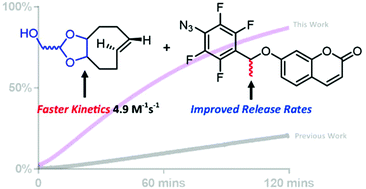Tuning activation and self-immolative properties of the bioorthogonal alkene–azide click-and-release strategy†
Abstract
We report on a series of 4-azidobenzyloxy-substituted self-immolative linkers which undergo [3 + 2]-cycloaddition (click reaction) with functionalized trans-cyclooctenes (TCOs) at second-order rate constants in the range of 0.017 to 4.9 M−1 s−1. The choice of 4-azidobenzyloxy-substituted linker and the TCO play a critical role in the rate of all click-and-release steps, which includes the [3 + 2]-cycloaddition and subsequent degradation pathway of the triazoline to an aniline that undergoes 1,6- or 1,8-self-immolation of the phenol. We demonstrate that reacting a 4-azido-2,3,5,6-tetrafluorobenzyloxy-linker with a highly strained TCO (d-TCO) gives, to the best of our knowledge, the fastest TCO-strained alkene–azide click reaction to date (4.9 M−1 s−1), but with one caveat; release of phenol via 1,6-self-immolation is extremely slow. A methyl substituent attached to the benzyl carbon of this analogue maintains the rapid click-reaction rate, but has the added benefit of enabling the release of the phenol within hours. In an aqueous solvent at reagent concentrations in the micromolar range a maximium release was observed after 48 hours; ≈65 and ≈78% of phenol released depending on the TCO used. The new suite of linkers and their combination with TCOs of varying structure add to the toolbox of bioorthogonal click-and-release reactions.

- This article is part of the themed collections: Editor’s Collection and Chemical Biology in OBC


 Please wait while we load your content...
Please wait while we load your content...